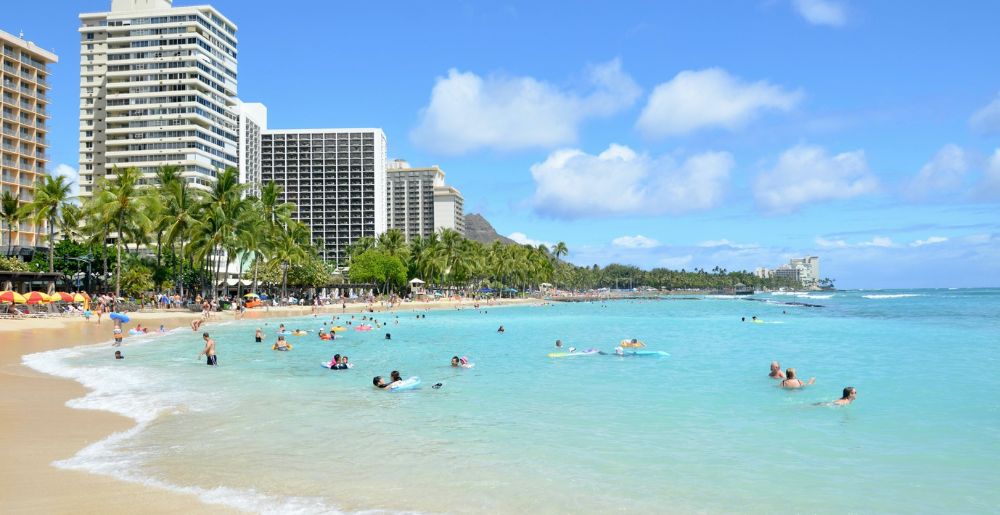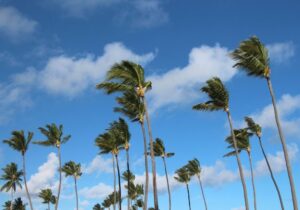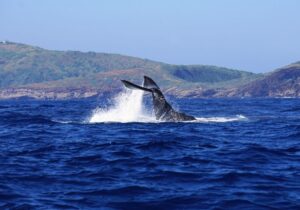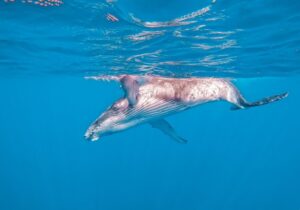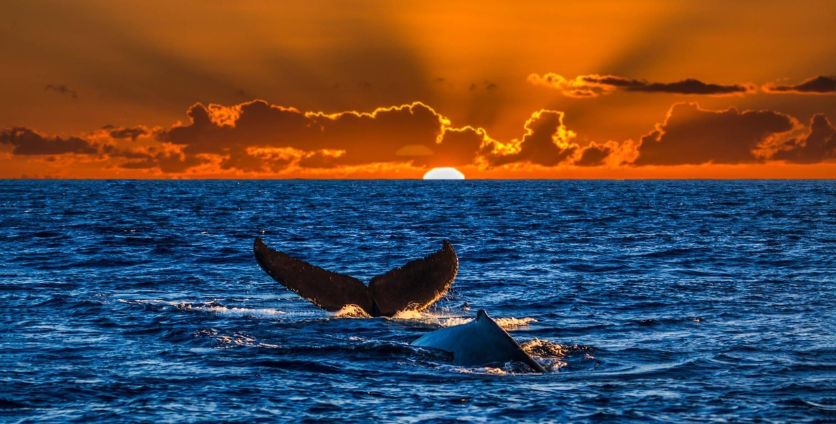When much of the world is bundling up against the cold, Honolulu offers a warm, sunlit escape that feels worlds away from winter. With daytime highs hovering around the upper 70s, gentle trade winds, and crystal-clear ocean conditions, it’s no wonder so many travelers head to Hawaiʻi’s capital to trade snow boots for flip-flops. Winter in Honolulu isn’t just about perfect weather — it’s also one of the best times of year to experience the island’s vibrant marine life, calm South Shore waters, and spectacular whale watching season. Whether you’re wondering what the weather is really like in January or which ocean tours are best this time of year, here’s everything you need to know before planning your winter getaway to paradise.
Winter in Honolulu Highlights:
- Perfect Weather: Daytime temperatures of 78–82°F with gentle trade winds and mostly sunny skies
- Warm Ocean Waters: Swim and snorkel comfortably in 76–78°F water year-round
- Humpback Whale Season: December–April brings thousands of whales to Hawaiian waters
- Calm South Shore Conditions: Protected waters around Waikīkī stay gentle while North Shore sees big surf
- Excellent Visibility: Winter offers crystal-clear water perfect for spotting sea turtles and tropical fish
- Less Crowded Tours: Boat-based activities provide intimate experiences away from busy beaches
What is Winter Like in Honolulu?
Average Temperatures and Weather Patterns
If you’re researching Honolulu January weather or wondering what to expect during Hawaii’s “cooler” months, you’ll be pleasantly surprised.
Winter temperatures in Honolulu:
- Daytime highs: 78–82°F (25–28°C)
- Nighttime lows: 65–70°F (18–21°C)
- Perfect for beach days and outdoor adventures
While locals might reach for a light sweater on cooler evenings, visitors from colder climates will find these temperatures absolutely ideal.
What about rain? Winter weather in Hawaii does bring occasional showers, but they’re usually brief and localized. You might experience a passing sprinkle in the morning that gives way to brilliant sunshine by afternoon.
Trade winds and conditions: The trade winds continue to blow during this season, keeping the air fresh and comfortable while creating those picture-perfect scenes of palm trees swaying against blue skies. These conditions make winter ideal for boat tours, coastal hikes, and spending long days exploring the island without the intense heat of summer.
How Crowded is Honolulu in Winter?
Winter in Honolulu does attract visitors eager to escape frigid temperatures back home, making December through February the peak season for tourism. Hotels and popular beaches can feel busy, especially around the holidays.
The good news for boat tours: Ocean-based excursions often provide a more intimate experience than land-based attractions. Once you’re out on the water, the vastness of the Pacific creates a sense of space and tranquility that’s hard to find on crowded shores.
Tips for avoiding crowds:
- Book tours in advance
- Schedule midweek when possible
- Choose early morning departures for calmer seas, clearer visibility, and fewer participants
- Opt for boat-based activities over beach visits
Ocean Conditions During Winter in Honolulu
Can You Snorkel in Honolulu in the Winter?
Absolutely! One of the best things about Hawaii during winter is that the ocean remains beautifully warm year-round, with water temperatures hovering around 76–78°F. You won’t need a wetsuit for most activities.
While winter does bring larger swells to Oʻahu’s famous North Shore (creating those legendary surf conditions you’ve probably seen on TV), the South Shore around Waikīkī stays remarkably calm. This makes boat-based adventures from the Waikīkī area particularly enjoyable during the winter months. Protected bays and nearshore waters maintain excellent visibility, and the slightly cooler air temperatures make the warm ocean feel even more inviting. Our Waikīkī snorkeling tours take advantage of these ideal conditions, bringing you to spots where the water is typically gentle and visibility is superb.
What About Rain or Windy Days?
Brief rain showers are part of winter in Honolulu, but they rarely interfere with ocean activities. In fact, light rain on the surface doesn’t affect what’s happening underwater — the sea turtles and tropical fish don’t mind a bit! Most winter days feature a mix of sun and clouds with perhaps a passing shower, but extended rainy periods are uncommon.
Morning tours generally offer the calmest seas and clearest water visibility, as winds tend to pick up slightly in the afternoon. That said, reputable tour operators closely monitor ocean and weather conditions for safety. If conditions aren’t suitable for a comfortable experience, tours will be rescheduled. The good news? Winter’s South Shore conditions are typically excellent, making cancellations rare.
Marine Life You Can See in Honolulu During Winter
When Is Whale Season in Hawaiʻi?
Here’s where winter in Honolulu truly shines: December through April marks the peak season for humpback whale sightings. Each year, thousands of humpback whales migrate from the cold waters of Alaska to the warm, shallow waters surrounding the Hawaiian Islands. They come here to breed, give birth, and nurse their calves in the protected bays and channels around Oʻahu. Check out our Guide to Whale Watching in Honolulu to learn more!
During these months, you might witness spectacular whale behaviors, including breaching (when whales launch themselves out of the water), tail slapping, and spy-hopping (when they poke their heads up to look around). The sight of a 40-ton whale launching itself into the air is something you’ll never forget. Mother whales with their calves are particularly magical to observe, often staying close to shore where the water is calmer. Our Whale Watching in Oʻahu tours are specifically designed to give you the best opportunities to witness these magnificent creatures in their natural habitat.
What About Turtles and Other Marine Life?
Hawaiian green sea turtles (honu) are year-round residents of Oʻahu’s waters, and winter’s excellent visibility makes spotting them even easier. These gentle giants can often be seen gliding gracefully through the water or resting on the sandy bottom. Swimming near a sea turtle is one of those transformative experiences that reminds you why Hawaiʻi is so special. Take a look at our Where to See Turtles in Oahu blog post to learn more!
Beyond turtles, winter waters teem with life. Spinner dolphins frequently visit nearshore areas, performing their characteristic acrobatic spins. The coral reefs remain vibrant with hundreds of species of colorful tropical fish, including the state fish, the humuhumunukunukuāpuaʻa (yes, that’s really its name!). Eagle rays occasionally glide by like underwater birds, and octopuses can sometimes be spotted tucked into reef crevices. Our Turtle Canyons Snorkeling Excursion provides a wonderful opportunity to encounter these amazing animals while learning about their behaviors and conservation.
Top Tips for Spotting Sea Turtles Responsibly:
- Maintain a distance of at least 10 feet from turtles
- Never touch or chase marine life
- Move slowly and calmly in the water
- Let turtles approach you on their own terms
- Use reef-safe sunscreen to protect their habitat
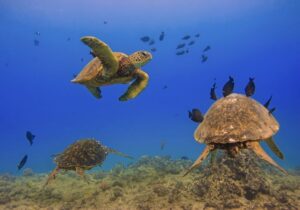
Why Should I Visit Honolulu in Winter?
The Benefits of Escaping Winter Weather
There’s something deeply restorative about trading snowdrifts and icy winds for palm trees and warm ocean breezes. When your friends are scraping ice off their windshields, you’ll be watching the sunrise from a boat, surrounded by turquoise water.
Beyond the obvious weather advantages, tropical travel during winter months offers genuine mental health benefits. Sunshine boosts vitamin D levels and improves mood, while the sound of waves and the slower island pace help reduce stress. Swimming in warm ocean water is both invigorating and calming. It’s nearly impossible to feel anxious while floating in 78-degree water watching sea turtles swim by.
Winter is a practical time to visit as well! While holiday weeks see higher prices, January and February often feature more reasonable rates than summer vacation periods. Flights from mainland cities are frequent and can offer good value, especially if you book in advance.
Seasonal Highlights & Activities
Winter in Honolulu offers experiences you simply can’t have at other times of year. Whale watching season alone makes this period special, but there’s so much more happening. The Honolulu Marathon takes place in December, bringing a festive energy to the city. The North Shore hosts world-famous surfing competitions where you can watch the world’s best surfers tackle massive waves. Sunset cruises become even more spectacular as the sun sets earlier, painting the sky in brilliant oranges and pinks while whales breach in the distance.
Top 3 Tours to Take This Winter:
- Whale Watching Cruise – Experience the majesty of humpback whales during their annual migration. These tours combine expert narration with thrilling wildlife encounters, and every trip is unique based on whale behavior that day.
- Turtle Snorkel Adventure – Swim alongside Hawaiian green sea turtles in their natural environment. Winter’s calm waters and excellent visibility make this an ideal time to explore Oʻahu’s underwater world.
- Waikīkī Sunset Boat Tour – Watch the sun dip below the horizon from the deck of a boat, with Diamond Head as your backdrop and the possibility of whale sightings adding to the magic.
FAQs About Winter in Honolulu
Is it warm enough to swim in Honolulu in January?
Yes, absolutely! Water temperatures in January average around 76°F, which is comfortably warm for swimming and snorkeling without a wetsuit. Many visitors find the ocean warmer than they expected, especially compared to beaches in California or other mainland destinations.
Does it rain a lot in Honolulu during winter?
Winter brings more rain than summer, but “a lot” is relative. Most days feature sunshine or partly cloudy skies with brief, passing showers. Extended rainy days are uncommon. When it does rain, it often occurs in short bursts — you might get a 10-minute sprinkle that leaves everything sparkling clean and then clears up completely. The rain also keeps the island’s mountains lush and creates beautiful rainbows.
What should I pack for a winter trip to Honolulu?
Pack primarily lightweight, summer clothing: swimsuits, shorts, t-shirts, sundresses, and sandals. Don’t forget reef-safe sunscreen (required by law in Hawaiʻi to protect coral reefs), a hat, and sunglasses. Bring one light jacket or long-sleeved shirt for breezy evenings or air-conditioned restaurants. If you plan to hike or spend time in upcountry areas, pack closed-toe shoes. Most importantly, bring your sense of adventure and openness to island time!
Is winter a good time for boat tours in Honolulu?
Absolutely — winter is actually one of the best times of year for boating. The South Shore waters around Waikīkī remain calm and protected, while whale season adds an extra element of excitement to every trip. Morning tours offer particularly beautiful conditions with glassy water and excellent visibility for underwater activities.
Ready to trade your snow boots for fins? Explore our boat and snorkeling tours departing from Waikīkī year-round, where warm water and unforgettable experiences await.

